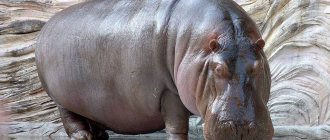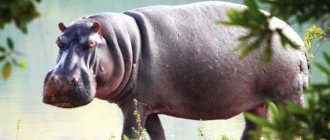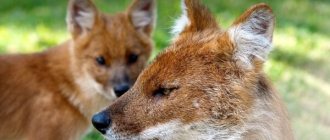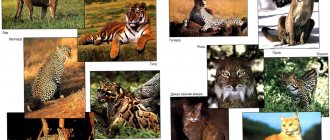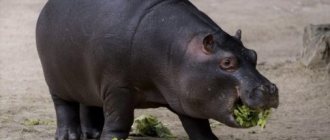Nutrition
For all their apparent danger, hippos are herbivores. Hippos choose pastures near water bodies familiar to them. There are no natural enemies for them in the wild, but they do not want to change familiar places. They like pastures with a lot of grass. If there is not enough grass, hippos can go on long journeys in search of new places where there will be enough food for everyone.
The feeding process of adult individuals is quite long and can take one fifth of the day. This is due to the fact that a hippopotamus is capable of eating up to forty kilograms of vegetation at a time. Hippopotamuses are not at all picky in choosing herbs; they like tree shoots, reeds, and other vegetation that can be found near their usual waters.
An amazing feature in the diet of hippos is that they can also eat the remains of dead animals that are found near bodies of water, although this happens quite rarely and is a deviation in their behavior. Scientists associate this fact with a lack of any nutrients, as well as with the health of the hippopotamus. This behavior is also considered strange because the digestion of hippopotamuses is not adapted for digesting meat.
Another difference between hippos and other herbivores is that they do not chew grass, but simply tear it with their teeth or sip it with the help of powerful lips that are created for this mission.
After a meal, hippos tend to return to their familiar body of water before sunrise, but if the hippo’s journey to the lush grass was long, then it can go into unfamiliar waters to rest. Hippos rarely move under the scorching sun.
Baby wild animals
The names of the cubs of many wild animals are similar to the names of domestic babies.
Tigers, cheetahs, pumas, lynxes, jaguars belong to the cat family. Their children are called kittens, for example, a lynx kitten.
Foxes, wolves, jackals are relatives of dogs. Dog cubs are called puppies, that is, a wolf baby will be called a wolf pup. The name wolf cub and fox cub are also correct.
There are names that repeat the name of the parents: lion cub, tiger cub, elephant calf, kangaroo cub, bear cub, deer cub.
What does a hippopotamus eat?
The hippopotamus is a large animal, so the question of what a hippopotamus eats, what hippopotamuses eat in their natural environment, is more than relevant. The diet includes at least 27 species of plants, most of which grow along the banks of the reservoir. The animal refuses to consume algae and other aquatic plants. Thanks to its powerful jaws, the animal manages to grab grass stems as close to their base as possible. One adult common hippopotamus and hippopotamus consumes up to 70 kilograms of green mass per day. The stomach is as long as possible for such large individuals, allowing it to digest food 2 times faster than an elephant or rhinoceros does. In this regard, the hippopotamus is lucky, since it needs 2-3 times less food to be full.
The pygmy hippopotamus eats exclusively green shoots and fruits, this is all they eat at any time of the year. An ordinary hippopotamus does not disdain carrion and is quite capable of catching and eating a doe or any other smaller animal. The need for meat food is a consequence of a lack of microorganisms and salt.
How do hippos feed?
We started our story with teeth. It is logical to assume that these animals need them for nutrition, like most representatives of the fauna. In fact, this is not so. Hippos are herbivores, and in this they are really close to horses. Like horses, cows, all artiodactyls, African giants are forced to peacefully nibble grass in order to eat. Moreover, they do this not with their teeth, but with hard lips, cutting off the juicy greens at the root.
When figuring out what hippos eat, it’s easy to assume that their food is lush and abundant underwater vegetation. But it would be completely wrong to think so! Hippos graze only on land; in the water they simply rest, hiding from the African heat.
And in the evenings, when dusk sets in, massive carcasses of hippos emerge from the water. Animals go to feed. It’s interesting that they always do this in the same places, often trampling real trenches in the soft soil—the paths of hippopotamuses. There are places where similar paths are made even in rocky formations. Apparently, multi-ton hippopotamuses have been using these “roads” for centuries.
A herd of hippopotamuses, having gone out for their “dinner”, spends the whole night on land, returning to their pond at dawn. It has been noticed that sometimes they move several kilometers away from the river. Oddly enough, hippos, despite their apparent slowness, are able to run fast. In any case, they overtake humans without difficulty, being, according to the indigenous inhabitants of the mainland, the most dangerous animals in Africa.
An adult hippopotamus eats about 50 kg of grass per night, which is quite a bit compared to its weight (up to 4 tons). This is explained by the fact that they have an incredibly long intestine, and grass, unlike other herbivores, can be processed almost completely.
Why do hippos have such big teeth? The answer is simple: “To fight!” These animals, especially males, are big fighters, often sorting out relationships with each other. In addition, hippos often do not have enough minerals, and they, like bulldozers, tear off the top layer of soil, eating it. This is done in places where the soil is salty.
Interestingly, there is a lot of evidence that hippos sometimes eat carrion in the wild, and also occasionally attack animals in rivers. Scientists tend to believe that they do this not so much for the meat, but, again, to replenish their reserves of salts and minerals. Probably, at such moments, hippos are also helped by their huge teeth.
The hippopotamus is indigenous to the African continent. This mighty beast lives nowhere else. There are two types of hippopotamuses - the common
and
dwarf
. The first species is also called a hippopotamus. It is known to almost everyone due to its size and appearance. When they say “hippopotamus,” they mean an ordinary one. As for the second type, it is significantly inferior both in size and in appearance.
The common hippopotamus or hippopotamus lives south of the Sahara. He lives near rivers, lakes and mangrove swamps. The name of the animal also indicates a craving for the water element. Hippo means horse in ancient Greek, and potamos means river. Literally it turns out to be a horse of the river. But the hippopotamus has no family ties with horses or pigs. Its closest relatives are whales.
A very long time ago, or rather 60 million years ago, the common ancestors of these mammals lived on earth. Then some of the animals went into the abyss of the water, and some remained on the earth's surface. This division occurred some 55 million years ago. Since those distant times, hippos have lived on land, and whales have lived in the seas and oceans. But the craving for the aquatic environment also manifests itself in terrestrial mammals. Therefore, the hippopotamus cannot live far from rivers and lakes.
Best articles: There is a dog, but there is no hair in the house: TOP-13 non-shedding breeds
The size of the common hippopotamus is very impressive. In terms of size, this animal ranks third on the planet among terrestrial mammals. The animal is second only to the elephant and rhinoceros. But in the order of artiodactyls he has no equal. And indeed, the average weight of an adult male ranges from 1.5 to 1.8 tons. The maximum weight can reach 3.5-4 tons. Females are smaller than the stronger sex. Their weight ranges from 1.3-1.5 tons. At maximum, ladies weigh 2.9-3.3 tons. Males grow throughout their lives. Females reach their largest size at 25 years.
The average height of a hippopotamus is 1.5 meters. Mature males grow up to 1.65 meters. The body length lies in the range of 3.3-5.2 meters. The tail grows up to 50-55 cm in length. Despite such impressive dimensions, the hippopotamus runs well. It reaches a speed of 30 km/h. True, at this pace the animal can run only 500-600 meters. However, if a powerful beast is chasing a victim, then this distance is quite enough to catch up with it.
Natural enemies of the hippopotamus
Hippopotamuses do not have many natural enemies. Lions and Nile crocodiles are dangerous for them. But even for these predators, adult males are difficult prey, since they are large, strong and armed with long fangs. When females protect their cubs, they also become very fierce and strong. If babies are left unattended, they are attacked by hyenas, leopards and hyena dogs. In addition, cubs can be accidentally trampled by adult members of the herd.
First of all, humans have a negative effect on the condition of the hippopotamus population. Its numbers are steadily declining due to poaching for meat and bones, as well as due to the destruction of the animals’ natural habitat. The last factor is associated with the growth of the population of Africa, and the corresponding occupation of new lands for agricultural needs; in this case, it is often the coastal lands where hippos live and feed that are being plowed. Irrigation, construction of dams and changes in river flows also negatively affect the population of this species.
Population and species status
Photo: Common hippopotamus
Over the past decade, the hippo population has decreased significantly, by about 15-20%. Between 125,000 and 150,000 individuals remain in approximately three dozen countries.
The main reasons for the decline in animal numbers:
- Poaching. Despite the ban on this illegal destruction of animals, many animals are killed by people every year. Animals that live in areas not protected by law are more susceptible to poaching than others.
- Deprivation of necessary habitat. The drying up of freshwater bodies of water, swamps, and changes in the direction of rivers lead to the death of animals, since they cannot travel long distances. The development of ever larger territories by humans, as a result of which the area and availability of places for grazing are reduced.
Interesting facts about hippos
https://youtube.com/watch?v=M40Tx04nFs0
The hippopotamus was and remains an insufficiently studied animal; the facts presented below will help fill in the existing problems in understanding its lifestyle and behavioral characteristics:
- A hippopotamus grows throughout its life.
- The tip of the hippopotamus's flat tail is covered with bristles. Their presence allows this part of the body to better cope with its task - splashing feces. With their help, animals mark their territory. They defecate in the same place. Along the banks of freshwater rivers and lakes you can often see real mountains of feces. The height and width of one such mountain can reach 1.8 and 2 meters, respectively.
- The statement that the hippopotamus is exclusively a herbivore is a myth based on observations of the life of exclusively dwarf representatives of the family. Ordinary hippopotamuses are dangerous predators that attack, including people. Their powerful jaws kill more people every year than from attacks by lions, rhinoceroses and crocodiles.
- The hippopotamus does not have sebaceous glands, so it must spend most of its time in water. In the sun, the body quickly dehydrates, the skin cracks, old wounds open and new wounds appear.
- From time to time, bloody streaks appear on the skin of the hippopotamus, reminiscent of sweat. In reality, they have nothing to do with blood. In extreme heat, the animal’s body generates a special pink liquid that protects the skin from the scorching sun and at the same time serves as an antiseptic. Under its influence, numerous wounds and cracks on the skin of the hippopotamus quickly heal.
- Hippopotamus milk is white. The information that the little hippopotamus feeds on pink milk and therefore reaches such gigantic sizes is one of the common myths. The pink tint is indeed present, but the reason for it is due to a special pink liquid covering the female’s skin.
- Females give birth to only 1 cub.
- The banks of the rivers that became the habitat of hippopotamuses are covered with deep tunnels, which are the result of subsidence of the earth under the heavy carcass.
- Hippos are not afraid of crocodiles; they share their habitat with them and even protect small crocodiles. Aborigines testify that young crocodiles climb onto the backs of hippopotamuses to rest and escape from their more ferocious relatives.
- The common hippopotamus is a nocturnal animal; it spends daylight hours in the water, exposing only its ears and eyes to the surface.
- The tusks and bones of hippopotamuses are extremely strong, their cost exceeds the price of elephant tusks.
- The animal skin, separated in a special way, is used to polish precious stones.
- Hippos do not like to travel, but if necessary they are able to cover considerable distances. So, in the middle of the last century, a hippopotamus named Hubert walked at least 1,600 kilometers across South Africa.
- If a hippopotamus stays in a fresh body of water for a long time (2-3 years), then this has a positive effect on the ecosystem. There is a sharp increase in the number of fish and other inhabitants.
- Hippos communicate with each other, emitting a deafening roar.
- If a weak animal meets a stronger one on its way, then in an attempt to avoid conflict, it lowers its head as low as possible, thereby expressing its desire to obey.
The hippopotamus is a dangerous artiodactyl, having a completely unattractive appearance, in no way deserving of the fate that man has prepared for it. Over the past 10 years alone, at least 10 thousand hippopotamuses have been exterminated in Africa, and compared to 1993, their population has decreased by 20 thousand individuals. The pygmy hippopotamus is on the verge of complete extermination.
Behemoth 4.3 (86.67%) votes: 12
Reproduction of hippopotamuses, care of offspring
Puberty of female common hippopotamuses occurs between 6 and 15 years, males become sexually mature by 6-14 years. Mating games begin in February and continue until the end of August. The offspring are born during the rainy season. Animals ready to mate dive into the water, but try to stay closer to the shore. Pregnancy lasts from 227 to 240 days and does not cause practically any problems to the already overweight female. An animal that senses the approach of childbirth leaves the herd. Childbirth takes place in water, or in high coastal thickets.
A newborn hippopotamus weighs from 30 to 50 kilograms, its body height reaches 0.5 meters, and its height is 1 meter. He is quite independent, gets to his feet 3-4 minutes after birth. If the birth took place in water, then the female pushes the baby onto land so that it does not suffocate. He will learn to swim well and stay under water no earlier than after 2-3 months, but he returns to the herd already on the 10th day after birth. The female takes care of the cub until it reaches 1.5 years of age. Before this, the small hippopotamus stays close to its mother, feeds on milk, which it also consumes when the female is in the water. Hippopotamus milk is extremely nutritious.
Top Articles: Which dog breeds are best for children?
The young common hippopotamus is born with 32 baby teeth. At one year of age, these teeth fall out and 36 permanent teeth grow in their place.
The desire of dwarf animals to stay apart makes it almost impossible to study the mating process of hippopotamuses in their natural habitat. Animals become sexually mature by the age of 3-4 years. In a zoo, they form stable monogamous pairs. Mating does not depend on the time of year, the duration of pregnancy is up to 200 days. The female gives birth on the shore, the newborn pygmy hippopotamus weighs only 6 kilograms, quickly gets to its feet, but does not dare to swim and dive for a long period of time. For the first 6-8 months, a baby hippopotamus feeds on milk.
Role in the ecosystem
Thanks to their massive build, hippos occupy an important place in the ecosystem. Everyday existence in water and on land creates an ideal habitat for small organisms. When a hippopotamus goes to graze, it tramples down a path, which during the rainy season will serve as a lagoon or side pool and allow small fish to protect themselves during drought.
As with all mammals, several types of parasites live on the external and internal parts of the body. Monogenic worms live on the outer surface of hippopotamus eyes. They are attached to the inner edge of the membrane and under the eyelid. Although they do not cause serious damage to the eyes, they are an irritant to animals. Leeches and mites are usually found around the anal area of the hippopotamus. Other than blood loss and irritation at the attachment sites, there is no serious damage from these parasites. Flatworms are found in the stomach and the first 1.5 meters of the small intestine. The tapeworm creates cysts in the muscles during the larval phase. Flukes are most often found in the liver of young hippos, and it is believed that as hippos age, they become immune to the parasites.
Dangerous herbivores
Hippos actually only eat grass, as well as soft fruits and other soft plants. Therefore, if they kill a victim, it is by no means due to hunger (what can we say, vegetarians!), but for other reasons.
Hippos are especially dangerous if there are cubs near them.
In such cases, they even attack cattle grazing on the banks. All predators in Africa are wary of the hippopotamus, because in a fit of rage it can bite a crocodile. There is a known case when a hippopotamus simply dragged a lion into the water, taking it by the scruff of the neck. It was there that the king of beasts simply choked.
They are also capable of aquatic predators. So, one day a herring shark swam from the sea into the Nile Delta. By the way, this is also a very dangerous animal, and not small at all: from 2.5 to 3 meters in length. So, the shark set its sights on the hippopotamus, but that was not the case. It would seem that the clumsy fat man dragged her ashore and trampled her. Well, aren't they stupid?
Well, what can we say about people: in a collision with a hippopotamus, only one thing can help - a weapon. A study was conducted in Kenya in which it was recorded that from 1997 to 2008, 4,493 situations were recorded when a hippopotamus showed aggression towards a person. Moreover, this figure is growing: everything is connected with the fact that hippos go out to the fields and trample the crops. And people, in turn, begin to cultivate the lands where animals live.
Natural habitat
Hippos inhabit only one continent - Africa, and even then they are found only in the eastern and southern parts of it. Previously, thick-skinned giants were found throughout the continent, were common in Algeria and Morocco, and in Egypt, populations of hippopotamuses lived in the waters of the Nile until the 20th century.
Hippos are native to Africa
Human activity in draining swamps and developing the natural pastures of hippos for farmland has led to a decline, and in some places, the complete disappearance of these animals. And centuries-old hunting has significantly reduced the once huge population of hippos, the situation especially worsened with the invention of firearms.
At the moment, the natural range of hippopotamuses is limited to the following countries:
- Mozambique;
- Kenya;
- Uganda;
- Tanzania;
- Zambia;
- Liberia;
- Malawi;
- Zimbabwe;
- South Africa (only in the Kruger National Park).
Hippos live in fresh water bodies, although sometimes they swim into salty river deltas. They prefer rivers and lakes with lush coastal vegetation, but they do not pay much attention to the purity of the water, and can even settle in a muddy swamp. But for hippos, the size of their territory is very important, because the larger and deeper the body of water, the less likely it is to dry out. Hippos are reluctant to leave their native places, and look for new water areas only if their river or lake dries up.
Description
Hippos are the second heaviest animals on earth. The first place is occupied by elephants, and in third place are rhinoceroses.
Scientists have long wanted to determine the origin of hippopotamuses, their pedigree since ancient times. For a long time, researchers thought that hippos and pigs had the strongest family ties. Their similar appearance spoke about this. But recent research has proven that hippos are related in origin to whales. This explains their semi-aquatic lifestyle.
The body of hippopotamuses is protected by a thick layer of skin. They can take on colors from violet-gray to gray-green. Skin color changes in the areas around the eyes and also around the ears of the animal. Here the skin may be brownish-pink.
The weight of an adult hippopotamus can reach 4000 kilograms. On average, these animals weigh from 1.3 to 3.2 tons. Hippos have a tail, its length can reach thirty-five centimeters. The body itself has a length of two to five meters. The height of an adult animal varies from 1.5 to 1.6 meters.
During fights in the wild, hippopotamuses can be injured because their outer layer of skin is not very strong. Hippopotamuses have almost no hair; the hairs covering the body are thin, almost invisible. More abundant fur can be seen only on the head and tail of the animal.
Interestingly, hippos have neither sweat nor sebaceous glands. Instead of the natural secretions we are accustomed to, their glands produce a viscous red liquid. At first, researchers thought the fluid was sweat and blood mixed together. But long research has shown that it is actually two acids mixed together. In combination with each other, they protect the animal’s skin from overheating, and also have an antiseptic and antibacterial effect. When exposed to sunlight, the liquid on the hippopotamus' skin changes color. If at first it is transparent, then it becomes brick-colored.
On land they can move at a speed of 30 km/h. And maintain such speed for quite a long time. In water, hippos can become even faster, this is explained by the structure of their limbs, which are adapted for movement in shallow waters.
Another interesting fact is that the structure of the hippopotamus’s head, namely its ears, nostrils and eyes, allows these animals not to swim to the surface for a long time, being under a layer of water, escaping from danger. At the same time, the animal can completely control what happens around it. If the hippopotamus completely wants to go under water, then it closes its ears and eyes, protecting them from water.
If we talk about the teeth and jaws of a hippopotamus, they can seem like quite formidable animals. Their fangs can reach a length of fifty centimeters, and their incisors can be forty centimeters in size. At the same time, hippos are able to open their mouths at an angle of more than 150 degrees, which looks very intimidating. But it must be said that this jaw structure meets the need to chew large amounts of grass, and not to hunt other animals.
It should be noted that hippopotamuses have a clearly visible gender identity. Males are much larger than females. Female hippos weigh only 200 kilograms, while male hippos can weigh several tons. Females grow for a limited amount of time, but males can grow larger throughout their lives. The jaws of males also look more intimidating compared to females.
The largest hippopotamus recorded by researchers weighed more than 4.5 tons.
Features of character and lifestyle
Photo: Hippopotamus in the water
Hippos are herd animals and live in groups. The number of groups can vary - from two to three dozen to two to three hundred. The group is always led by a male individual. The main male always defends his right to leadership. Males often fight very brutally in the struggle for primacy, as well as for the right to enter into mating relations with a female.
A defeated hippopotamus often dies from a large number of wounds inflicted by powerful and very sharp fangs. The struggle for leadership among males begins when they reach the age of seven. This is manifested by yawning, growling, throwing manure and clenching the jaws. Females are responsible for peace and tranquility in the herd.
Groups typically occupy a certain territory in which they spend almost their entire lives. During daylight hours they mostly sleep or bathe in the mud. When darkness falls, they leave the water and eat. Animals tend to mark their territory by spreading manure. In this way they mark the coastal zone and grazing territory.
Within a herd, animals communicate with each other using various sounds. They make sounds similar to grunting, smacking, or roaring. These sounds convey various signals not only on land, but also in water. A pose with the head down means bowing to older and more experienced members of the group.
Interesting fact. Hippos tend to make sounds even when they are completely immersed in water.
Often, when in the water, the animal's body is used by a large number of birds as a fishing ground. This is a mutually beneficial cooperation, since the birds rid the hippos of a large number of insects that parasitize the giant’s body.
Hippos only at first glance seem clumsy and clumsy. They are capable of reaching speeds of up to 35 km/h. It is not for nothing that they are considered the most unpredictable and dangerous animals on earth. Incredible strength and huge fangs allow you to cope with even a huge alligator in the blink of an eye. Adult males and females with their babies near them are especially dangerous. A hippopotamus can trample its prey, eat it, bite it with its huge fangs, or simply drag it under water.
Lifestyle
- Hippos are social animals and live in herds
of 20-30 individuals, but sometimes this number reaches 200. - The herd is led by a male leader
, who is constantly forced to prove his right to a harem. How many fights! Fierce fights occur between males for the female - opponents inflict wounds on each other with their fangs, which often ends in the death of the loser. Due to such fights, many scars can be seen on the skin of the hippopotamus. - The pygmy hippopotamus, like a tapir, keeps to itself and does not show aggression towards its fellow tribesmen and does not protect its possessions. Sometimes a pair of such hippopotamuses live together.
- The animal's body quickly loses water, so it spends most of its time in water. The hippopotamus comes ashore at night to find food.
- Pygmy hippos spend more time on the shore, but they also need regular daily baths to prevent their skin from drying out and cracking.
- As a rule, hippos live near fresh water, although they are occasionally spotted in the sea.
Best articles: Areas of altitudinal zonality, or altitudinal zonality
Latin name Hippopotamus
taken from the ancient Greek language, and means
"river horse"
. This is what the ancient Greeks called a giant beast that lived in fresh water bodies and made sounds reminiscent of the neighing of a horse.
In Russia and a number of CIS countries, the hippopotamus is usually called a hippopotamus, and the roots of this name are biblical. The word behemoth
in the book of Job one
monster is named - the embodiment of carnal desires
.
In general, both names mean the same thing.
Who is not familiar with the appearance of this animal: huge, at first glance, clumsy, sitting for hours in the warm water of some calm African river! Many of us, even those who have never been to Africa, have seen hippos with our own eyes, because they easily take root in captivity and are frequent residents of zoos. Hippopotamuses often open their mouths, and then everyone sees huge fangs and teeth, in comparison with which even the fangs of a lion seem like toys. Do these animals really need such terrible teeth to eat? And in general, what do hippos eat in the wild?
Hippopotamus - description, characteristics, structure.
Due to its unique appearance, the hippopotamus is difficult to confuse with any other animal. Hippopotamuses are distinguished by a giant barrel-shaped body, and in its dimensions the hippopotamus competes with the white rhinoceros and is slightly inferior in size. After the elephant, the hippopotamus (like the rhinoceros) is the second heaviest land animal. The hippopotamus grows throughout its life; at the age of 10 years, hippopotamuses of both sexes weigh almost the same, then males begin to gain weight much more intensively than females, and then a difference between the sexes appears.
The massive body of the hippopotamus ends in such short legs that when walking, the animal’s belly practically touches the ground. Each foot has 4 toes, at the ends of which there is a kind of hoof. There are membranes between the toes, thanks to which the hippopotamus swims well and does not drown when walking on swampy soil.
The tail of the common hippopotamus, growing up to 56 cm, is thick and round at the base, gradually narrows and becomes almost flat towards the end. Due to this structure of the tail, the hippopotamus is able to spray its droppings over a considerable distance, right up to the tops of trees, marking its individual territory in such an unusual way.
The huge head of a hippopotamus makes up a quarter of the total body mass and in an ordinary hippopotamus can weigh almost a ton. The anterior section of the skull is slightly blunted and in profile has the shape of a rectangle. The ears are small, very mobile, the nostrils are widened, sticking up, the eyes are small, buried in fleshy eyelids.
The ears, nostrils and eyes of a hippopotamus are set high and located in one line, due to which the animal is almost completely immersed in water, while continuing to breathe, look and listen. In dwarf hippos, the eyes and nostrils do not protrude beyond the head as much as in ordinary hippos.
A male hippopotamus can be distinguished from a female by the pineal-shaped swellings that are located on the side of the nostrils. These swellings are the bases of the male's large fangs. In addition, females are slightly smaller than males, and females have smaller heads in relation to their bodies.
The hippopotamus's muzzle is wide, dotted with short, hard vibrissae in front. The giant mouth opens, forming an angle of 150 degrees, and the width of the powerful jaws of an ordinary hippopotamus is 60-70 cm.
The common hippopotamus has 36 teeth covered with yellow enamel, among which the fangs and incisors stand out. In total, on each hippopotamus jaw there are 6 molars, 6 premolars, 2 canines and 4 incisors; Dwarf hippopotamuses have only 2 incisors. Males have especially developed sharp sickle-shaped fangs with a longitudinal groove, located on the lower jaw. As the animal grows, the fangs bend back more and more. Some hippopotamuses have fangs that reach a length of more than 60 cm and weigh up to 3 kg. With the loss of the opposite canine of the upper jaw, physiological grinding becomes impossible, and the fangs grow up to 80 cm, and sometimes over 1 meter in length, piercing the animal’s lip and making it difficult to eat.
The hippopotamus is an extremely thick-skinned animal, only at the base of the tail the skin is thin, and throughout the body the thickness of the skin is 4 cm. The color of the back of the hippopotamus is gray or gray-brown. The belly and areas around the eyes and ears are pink. There is practically no hair, with the exception of short bristles on the tip of the tail and ears. Very sparse, barely noticeable hair grows on the sides and on the belly.
Hippos do not have sweat or sebaceous glands, but they do have special skin glands that are characteristic only of these animals. In intense heat, a red mucous secretion appears on the skin of the hippopotamus, so it seems that the animal is covered in bloody sweat. In addition to protecting against ultraviolet radiation, the red secretion acts as an antiseptic, healing numerous wounds that regularly appear on the body of animals. Also, the red sweat of a hippopotamus repels blood-sucking insects.
The fatness and slowness of the animal can be deceptive - the speed of a hippopotamus can reach 30 km/h. An adult animal takes only 4-6 breaths per minute, thanks to which a hippopotamus can dive and remain without air for up to 10 minutes.
Communicative communication is very typical for hippos: with the help of a voice reminiscent of grunting, roaring or a horse neighing, animals express their emotions and transmit signals both on the shore and in the water. A pose of submission, with the head bowed low, is expressed by weak hippos when they come into the field of view of the dominant male. Spraying droppings and urine is a very important way of marking personal territory. With piles of feces 1 m high and 2 m wide, the hippopotamus marks individual paths and daily renews unique beacons.
